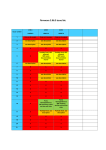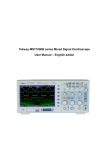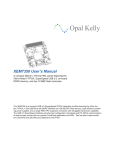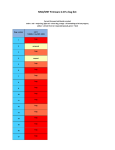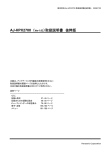Download Hantek Tekway Firmware 2.06.x bugs
Transcript
Firmware 2.06.3 bug list: Current firmware bold border marked. Colors : red - bug, light red – minor bug, orange - sill something to fix but progress, yellow – almost there …, green – fixed 2.06.3 2.06.3 2.06.3 2.06.3 2.06.3 120224.0 120423.0 120808.0 121027.0 130114.0 1 Only on B models Only on B models fixed fixed fixed 2 see description see description see description see description see description 3 see description see description see description see description see description BUG BUG Some progress, but function disabled in this fw version Some progress, but function disabled in this fw version Some progress, but function disabled in this fw version 5 BUG Partially fixed -GPL released, SDK some documentatio n shared Partially fixed -GPL released, SDK some documentati on shared Partially fixed -GPL released, SDK some documentati on shared Partially fixed -GPL released, SDK some documentati on shared 6 see description see description see description see description see description 7 BUG BUG BUG Removed from to-do Removed from to-do 8 BUG BUG BUG BUG BUG 9 BUG see description Fixed Fixed Fixed 10 BUG see description Fixed Fixed Fixed 11 BUG BUG Fixed Fixed Fixed 12 BUG BUG Fixed Fixed Fixed Bug number 4 Bug number 2.06.3 2.06.3 2.06.3 2.06.3 2.06.3 120224.0 120423.0 120808.0 121027.0 121208.3 13 BUG BUG BUG BUG BUG levels better, but not yet 100% ok 14 BUG BUG fixed fixed fixed 15 BUG BUG See description See description fixed 16 BUG Fixed, /dso/app/dsod as WD checking profile and dso.exe state Fixed, /dso/app/dso d as WD checking profile and dso.exe state Fixed, /dso/app/dso d as WD checking profile and dso.exe state Fixed, /dso/app/dso d as WD checking profile and dso.exe state 17 BUG Partially fixed, see description Fixed Fixed Fixed 18 BUG BUG BUG BUG BUG 19 BUG BUG BUG BUG BUG 20 BUG BUG BUG BUG BUG 21 BUG BUG BUG BUG BUG 22 BUG BUG BUG BUG BUG function disabled in this fw version function disabled in this fw version 23 BUG BUG function disabled in this fw version 24 BUG BUG See description See description See description 25 BUG BUG BUG almost fixed, see description Fixed 26 Not exist in this version Not exist in this version See description See description BUG 27 Not exist in this version Not exist in this version BUG BUG Fixed BUG Fixed Fixed 28 BUG BUG Bug number 29 2.06.3 2.06.3 2.06.3 2.06.3 2.06.3 120224.0 120423.0 120808.0 121027.0 121208.3 BUG BUG BUG BUG BUG 30 BUG BUG BUG BUG OK with 40 and 50Frame/s Screen Refresh rate 31 BUG BUG BUG BUG Fixed 32 Not exist in this version Not exist in this version Not exist in this version Not exist in this version Not exist in this version 33 OK BAD BAD BAD BAD 34 BUG BUG BUG BUG BUG 35 Not exist in this version Not exist in this version Not exist in this version Not exist in this version Not exist in this version 36 Not exist in this version Not exist in this version Not exist in this version Not exist in this version Not exist in this version 37 BUG BUG BUG BUG BUG 38 BUG BUG BUG BUG BUG 39 BUG BUG BUG BUG BUG 40 BUG BUG BUG BUG Fixed List of bugs/improvement requests 1. Select any of the new functions like “Printer Cfg”, “Option, Wave” (any many others), push HELP button on the front panel and the DSO is crashing and not responding anymore. 2. Apply test signal, do auto setup to trigger properly. Set time base to 4ns/DIV, change Acquisition mode from “Real Time” to “Equ Time”, hide menu by pushing F0, turn time base knob from 4ns/DIV to 2ns/DIV and DSO is crashing and not responding anymore. This bug seems to exist only on DSOs where the factory calibration (not self-calibration!) is somehow invalid. After user-executed factory calibration bug disappeared. Is there something in “chk1kb_091023” which can be changed to fix that? (User-executed factory calibration is not an option). 3. Apply test signal, do auto setup to trigger properly. Set time base to 4ns/DIV, change Acquisition mode from “Real Time” to “Equ Time”, hide menu by pushing F0. When menu hidden you can see artifacts on the right side of the screen. They don’t need to be there. This bug seems to exist only on DSOs where the factory calibration (not self-calibration!) is somehow invalid. After user-executed factory calibration bug disappeared. Is there something in “chk1kb_091023” which can be changed to fix that? (User-executed factory calibration is not an option). 4. Digital Filters to be implemented. 5. SDK to be released 6. Update FPGA design to match ADC skew/timings in 125MHz/1GSs mode (this is already known issue and listed in old “issue list”, posting once again in this list as reminder) FPGA design revision 83E8 sample rate 1GS/s clocks skew (must be always 1000ps): Clock 8->Clock 1: 1010ps Clock 1->Clock 7: 1250ps Clock 7->Clock 2: 550ps Clock 2->Clock 6: 1230ps Clock 6->Clock 3: 1000ps Clock 3->Clock 5: 1280ps Clock 5->Clock 4: 500ps Clock 4->Clock 8: 1250ps FPGA design revision 83E8 sample rate <= 800MS/s clocks skew (must be always 1250ps): Clock 8->Clock 1 1250ps Clock 1->Clock 7 1260ps Clock 7->Clock 2 1280ps Clock 2->Clock 6 1230ps Clock 6->Clock 3 1260ps Clock 3->Clock 5 1280ps Clock 5->Clock 4 1230ps Clock 4->Clock 8 1260ps FPGA design revision 83E9: not yet measured, but Hantek statement “It's impossible for us to achieve it now” is not really optimistic. 7. add 20ksamples/16ksamples/8ksamples (whatever possible, if possible) to memory depth, preferred with highest possible sample rate. This is in principle what already published as “available” In the user manual or on Tekway and Hantek websites. This was only proposal, it has been removed from to-do as “not important”. I’m fine with that as long other bugs would get fixed! 8. In single window, sample memory >=40k, both channels (ch1, ch2) enabled and time base from 400ns/div up to 2ns/div the position change (fine and coarse) control is not working. Only scale is moving, but not the waveform. See attached picture to understand issue: with 4k memory when changing position waveform is moving with 40k and above, when moving changing time base position waveform is NOT moving when in RUN mode (but works in STOP mode) 9. In single window mode, sample memory 40k, both channels (ch1, ch2) enabled – while switching to dual window mode artifacts on screen and DSO later crashing and not responding. Artifacts disappear when changing timebase just after switch to dual window, so just an init error? Set like on picture and switch dual window mode to see artifacts like this: 10. In single window mode, sample memory 512k, both channels (ch1, ch2) enabled – when switching to dual window mode artifacts on screen and DSO later crashing and not respondin Artifacts disappear when changing timebase just after switch to dual window, so just an init error? Set DSO like on picture and switch dual window mode to see artifacts like this: 11. In FFT mode the Display -> Grid option is not changing the grid, it is always “real line” and not possible to change to “dotted line” or “off”. 12. In FFT mode “Full span” is higher than Nyquist (sample rate /2 ) Example: 800ns/DIV, sample rate is 200MSs, full span 125MHz. Easy to fix by enabling from 800ns/DIV to 20ns/DIV 1GSs sampling (when 4k memory or FFT enabled) 13. AC trigger indicator and line wrong. Set ch1, signal DC coupled, trigger AC coupled. The trigger lowest level below signal : highest level only mid of signal But both should look like when trigger coupled in DC mode: 14. Dithering/interpolation filter of waveform too sharp. When enabling both channels (this also occurs in single channel mode and 1GSs, but test signal need to be higher to get same error) and applying for example 16MHz square wave the waveform is switching between proper square: and crippled square every second: 15. Display / Time base scaling strange behavior. When you apply e.g. 1kHz signal, set time base to 80us/DIV and move the waveform to 500us/DIV (bug only in 4/40k memory depth, 512k/1M/2M works fine): When you now change time base to 40uS/DIV the falling edge (which should be still in the middle of the screen) has been moved to 454uS position (but it should stay on 500uS). The same happens of course with 20uS/DIV. 16. Develop failsafe into rcS script. Currently when firmware does have bug and DSO is crashing, or even with no bug but when user is powering off the DSO while the dso.exe is saving the profile/DSO settings into the /param/sav/run1kb_xxxxx file it is possible that this file will get damaged. When this happens DSO is not starting up properly. The failsafe can be separate executable loaded in rcS before dso.exe is loaded. This file will then check if “default button” is pressed. If so, this executable will purge settings/profiles and terminate itself. The dso.exe will then start up with default settings as no profiles saved. 17. The new function “Wave” is no working properly in some models. There is missing the directory /param/sav/wave_sav on 2.6.13 kernel loaded DSOs. Additionally there is typo in ARM source code, a_hws DCB ".hws",0 once the file extension is .hsw and another time it is .hws – this is preventing the save/reload from USB to work properly and even sometimes crashing DSO. From the file format I assume .hws is the proper file extension name 18. The protocol.inf file in every 2.06.03 firmware (DSO5xxxB, BV, BMV and DSO1xxxB) contains error in the definition of [TRIG-SWAP-CH1-PULSE-TIME]. It is defined as “1” byte long but it should be “8” byte. The firmware itself is using 8 byte, only the “protocol.inf” file is wrong. 19. The protocol.inf file in ever 2.06.3 firmware (DSO5xxxB, BV, BMV and DSO1xxxB) contains error in the definition of ALT trigger. The entries for ALT-O.T.CH1 and ALT.O.T.CH2 are missing : [TRIG-SWAP-CH1-VPOS] 2 [TRIG-SWAP-CH1-OVERTIME-NEG] 1 [TRIG-SWAP-CH1-OVERTIME-TIME] 8 [TRIG-SWAP-CH2-VPOS] 2 [TRIG-SWAP-CH2-OVERTIME-NEG] 1 [TRIG-SWAP-CH2-OVERTIME-TIME] 8 20. Every 2.06.3 firmware (DSO5xxxB, BV, BMV and DSO1xxxB) contains error in the ” Trans_DSOeachData” and “Trans_PCeachData” functions. The “g_FFTWin” table is defined too small, due this SYSData FFT status is having only 0x00 : hanning 0x01 : flattop 0x02 : rectangular Barlett and Blackman are missing (always sending 0x00 and 0x01 instead of 0x03 and 0x04) 21. In every 2.06.3 firmware (DSO5xxxB, BV, BMV and DSO1xxxB) in SYSData definition the field for FFT -> Vrms is missing, only dBrms available. 22. Every 2.06.3 firmware (DSO5xxxB, BV, BMV and DSO1xxxB) contains error in the “Trans_DSOeachData” and “Trans_PCeachData” functions. The “g_MSItem” table is defined too small, is having only 0x0B size but since year there are 22 measurement’s available. 23. Equivalent sampling not working properly. 24. No real difference when changing Screen Refresh rate (Auto, 30, 40, 50). It looks like “30” is maximum what the current firmware is able to handle, when changing to “40” or “50” no visible difference. This seems to be the case in all firmware’s since end of Nov 2011. This was one of the unique features and need to be changed back to what it was before! Edit- a little bit better, Auto and 30 are ok, but 50 is still equal to 40 (but it should refresh faster) I got told that there is no room for improvement, the firmware is running with “full speed” Honestly I don’t believe that, but for now I would say “fix other bugs first”. 25. Waveforms in memory (in some combination of Timebase and memory depth), in display memory and exported data having at begin or/and end of the waveform random data. Also the buffer length seems to be not as it should be, e.g. 4100 instead of 4000 samples. This error seems to be in all firmwares since Mid-December 2011. UPDATE: Exported (csv checked, other formats not because they not documented nor open) data seems to be fine. Display data seems to be fine for Normal and Peak sampling, in average probably still some issues (not sure if this is now related to bug nr. 27 or if still belongs to 25). 26. While switching to Dual Window (F7) , if WTB < MTB, the MTB displayed value is not always set properly. Up to fw 120423.0 it was working properly, in 120808.0 and 121027.0 the MTB scale changed in a completely wrong way (see bug 27), in fw 121208.3 following behavior: This seems to be only issue when MTB < WTB, with MTB=WTB it does works properly. Example1: 4k depth, 5MHz signal, 40ns/DIV WTB now when we change with F7 to dual window the top window is showing wrong scaled waveform, the resulting bottom zoom window showing as well wrong : when we turn now the Timebase knob one position “up” (200ns/DIV is actually to max “up” position for MTB by 4k depth, but by turning the know firmware is updating windows) the waveform in top and bottom window is properly scaled: Example2 : 40k depth, 5MHz signal, 40ns/DIV WTB now when we change with F7 to dual window the top window is showing wrong scaled waveform, the resulting bottom zoom window showing as well wrong : when we turn now the Timebase knob one position “up” (4us/DIV is actually to max “up” position for MTB by 40k depth, but by turning the know firmware is updating windows) the waveform in top and bottom window is properly scaled: 27. While switching from single into dual window mode the main timebase is changing with a wrong factor, e.g. from 200ns/DIV in single into 400ns/DIV in dual window mode. Similar issue in 40k/512k and 1M – in dual window the MTB is twice that high as before in single window mode. Due incorrect timebase the display buffer is showing artifacts on both right and left side of the waveform (end of buffer). Example: CH1 enabled, 40k memory, single window and windows timebase smaller than main timebase, here 400ns/DIV (Main TB is 4us/DIV for 40k) Now when switching to dual window the Main TB is changing to wrong value (here from 4us/DIV to 8us/DIV – actually it will be always doubled in length) and artifacts from “end of buffer” right and left in top window are shown: When the Acquisition would be stopped and restarted or Timebase changed one position forth and back (while Main window is focused) the Main TB and displayed data will be fixed to proper length; no artifacts shown anymore: With 2 channels enabled this bug DOES NOT EXIST, this is because the doubled Main TB value is exactly what it should be for dual channel view: 28. Someone told me that there was “problem in csv exported data, no timestamp inside. This seems to be fixed in 2.06.3_121027.0”. Honestly, I see timestamp in scientific format but no idea if this is really fixed; for me it’s a bit strange when multiple data points are on same stamp, e.g. (steps are here in ns valued but then cut in format): 1.58E-03,0.000 1.59E-03,0.080 1.59E-03,0.080 1.59E-03,0.080 If the smallest step is e.g. 40ns then timestamp for every point should be always in ns and not increasing: 4.00E-07,0.002 8.00E-07,0.000 12.00E-07,0.002 16.00E-07,0.000 29. Horizontal Position knob not moving display data. Set Trigger to “Normal” – when DSO not triggered the waveform/horizontal screen position cannot be changed. Once triggered it changing rapidly. Another example – set trigger to Single Seq and Auto , while trigger in “R” (ready) mode waveform/horizontal screen position cannot be moved. Again, once triggered it change rapidly. In firmware 110923.1 this was working! : but since few firmware version not anymore working (same condition, Horizontal position knob already turned few times but no move on screen): 30. Cursor cannot be moved smoothly anymore. Every firmware update is slowing down more and more the V0 knob response. In firmware 110923.1 every kind of cursor was easy movable, in latest firmware (121027.0) is crazy slow, stumbling while changing V0 knob position. Generally, bug 29 and 30 have something to do (in my opinion) with the fact that screen data is dependent on trigger. You can easily see the difference e.g. in cursor, while moving them with no trigger (e.g. normal mode, trigger level above signal level) the cursor is working just fine. Maybe it would be good idea to remove the trigger event link from screen refresh (why is this linked together anyway? It cannot be necessary for the firmware because older versions never had this bug). 31. In RUN and STOP mode, while changing Timebase the Time Cursor values S and E not refreshing automatically. Any changes to Menu (hide/show with F0), other Knobs (like V0) position or any Buttons (e.g. push Measure button and again Cursor button) is refreshing the S and E values in Menu. Here example, TB set to 80ns/DIV, cursor S to 0.0ns and E to -160ns: Then TB changed to 40ns/DIV, but displayed value for E still -160ns: Now disabling Menu with F0: and enabling Menu again with F0. The E cursor value is now having proper value (-80ns): This was working properly the last time in firmware 110923.1 32. Request – add Edge Trigger on both falling and rising edges simultaneously. 33. Debug symbols (.stab and .stabstr sections) removed (stripped) since 120423.0 from dso.exe file. Why that? It seems that you guys don’t want to spend money for Quality Control or Firmware Testing in-house, there was not a SINGLE ONE firmware update in last 3 years without new bugs, “small mistakes”, typos, etc. I can’t believe that your engineer don’t see all these things, but probably in hurry not checking everything. Fine (actually not really fine, but based on the small revenue I can understand this), we can do the QC and Testing for you (and continue to update this Bug List), but without debug symbols you slowing down us, and our time costs money as well! You can as well release each time two versions – one with and one without debug symbols, there is not a real work effort for you. 34. CSV Exported data, if MTB from 40s/DIV to 4ms/DIV the amount of samples is wrong as well the displayed MTB value seems to be wrong. Example : 4k depth, 4ms/DIV -> CSV shows #timebase= -294967296(ps) and not 4000000000(ps) 40k depth, 4ms/DIV -> CSV shows #timebase= -294967296(ps) and not 4000000000(ps) 512k depth, 4ms/DIV -> CSV shows #timebase= -294967296(ps) and not 4000000000(ps) 1M depth, 4ms/DIV -> CSV shows #timebase= -294967296(ps) and not 4000000000(ps) 4k depth, 8ms/DIV -> CSV shows #timebase= -589934592(ps) and not 8000000000(ps) .. 1M depth, 8ms/DIV -> CSV shows #timebase= -589934592(ps) and not 8000000000(ps) 4k depth, 20ms/DIV -> CSV shows #timebase= -1474836480(ps)and not 20000000000(ps) .. 1M depth, 20ms/DIV -> CSV shows #timebase= -1474836480(ps)and not 20000000000(ps) The number -294967296 is nothing else than buffer overflow by 3999999999, -589934592 buffer overflow by 7999999999, etc. A quick check of “SaveWaveDataToCSVFile” shows the problem source -> sprintf “#timebase=%d(ns)\r\n," is using %d but I think %lld was supposed to be there to allow maximum of 40s/DIV to be saved in pico seconds. The “RecallCSVDataToDispBuf” need of course to be changed as well to allow read-back of the CSV data longer than 2000000000 ps. 35. Request – remove following automatic “20MHz lowpass filter” : - while changing from 5mV/DIV to 2mV/DIV (the user can enable it if he/she need it, automatic lowpass is annoying) - if Volt/DIV already 2mV/DIV, 20MHz lowpass off -> while changing Memory Depth (this one is really annoying, user have to go back to channel, disable filter, go back to acquire menu to continue to work ) 36. If possible change the Frequency Counter to display in mHz resolution when counter value between 1Hz and 99.999kHz (99999Hz). If not possible change displayed value to cut (trailing) zeros, when there is no mHz no need to see zeros instead (e.g 10Hz should be shows as 10Hz and not 10.0000Hz). This might be sometimes very confusing for the user, imagine e.g. frequency of 32.768Hz – the counter will show 32.000Hz (and Wave measure 32.76Hz). 37. With Long Memory enabled (40k, 512k, 1M, 2M?) when the WTB is 400ns/DIV (and lower, up to 2ns/DIV) when enabling second channel the indicator in status line will be already displayed but the waveform is missing. Additionally the CH2 LED is off : But after changing Timebase (or wave position) one position forth and back the second channel waveform will get displayed and LED gets on : 38. MTB Area indicator is blinking! Select 40k depth (or 512k), enable both channels set WTB to 400ns/DIV or 200ns/DIV and watch the area blinking : 39. Within FFT the information in status bar is not always showing the proper sampling rate, sometimes even jumping from proper to bad value. As the FFT cursor is taking in count the sampling rate, the measure value might be not correct. Example random values in 800ns/DIV FFT , here 100MS/s then 250MS/s (but still 800ns/DIV) and here 500MS/s (but still 800ns/DIV) 40. Flash Drive directory listing (in CSV Save/Recall and DSO Setup Save/Recall menus) is showing maximum 10 files. Additionally no option to scroll over the directory to choose other than one of the listed 10 files List of workarounds – by bug number I’ve marked all workarounds with colors: red – bad one, yellow – sill bug, but workaround exists, green – not a bug or I don’t care about. Note – these colors represents what I think and feel. Update: Some of them already fixed 1. Don’t use help 2. Run factory-calibration (only Edge calibration) and after that self-calibration. This bug seems to be only valid for hacked models, it does not exist on real 200MHz models (on which the factory calibration was executed after 2ns/DIV and other 200MHz features has been enabled). 3. Run factory-calibration (only Edge calibration) and after that self-calibration. This bug seems to be only valid for hacked models, it does not exist on real 200MHz models (on which the factory calibration was executed after 2ns/DIV and other 200MHz features has been enabled). 4. No Workaround available. 5. Well, you can build your own SDK/LabView/what so ever support based on the already published information’s: http://www.mikrocontroller.net/articles/Hantek_Protokoll http://elinux.org/Das_Oszi_Protocol 6. There is no affordable workaround for now. Changes to hardware are possible but expensive. I’ve tested Silicon Labs jitter cleaner, Murata LDHxxx delay lines and a combination of other solutions. I was more than satisfied with achieved results, expect the costs. For now we have to use what available, both manufacturers developed within last 2 years few FPGA design versions, the best is from upcoming Tekway MST DSOs and Hantek Handhelds – however they not allowing dual channel 500MS/s sampling in long memory; Hantek’s bench DSO hw1007 83E9 design allows such faster sampling but the skew is still far from perfect. I did publish all these FPGA designs, you can play with them to which is best for you. But note – do not do this when you own hw1005 DSO, they can’t be modified! For those of you who don’t know what this bug means – Google for waveform/interleave distortion and/or Agilent 5989-5732EN. 7. This is improvement proposal and not a bug. It has been removed from to-do as “not important”. 8. This is a very unfortunate bug; possible workaround is to use dual window mode or less memory depth (both with disadvantages) 9. Workaround is to change Timebase (just one step forward and back) right after dual window enabled. Note – the main window (top) need to be activated, the bug have something to do with main TB buffer initialization. 10. Workaround is to change Timebase (just one step forward and back) right after dual window enabled. Note – the main window (top) need to be activated, the bug have something to do with main TB buffer initialization. 11. This is improvement proposal and not a bug. 12. Use my firmware (2.06.3_120507.6), I removed that bug. 13. Use DC trigger coupling or “add offset” when you set trigger point. On some other good known DSOs (e.g. Tektronix TDS7xxx) there is exact the same DC-signal/AC-trigger “dependency” (bug) and nobody ever complained about. 14. For sure a stupid bug, but since you can see when the signal is “wobbling” you can quick change (when necessary) to single channel to observe the waveform with better resolution and without wobble. 15. Funny bug, but easy to omit since we know it (remember, with higher sample depth there is no issues) 16. This is already fixed, the /dsod (or /dso/app/dsod – this depends on fw/DSO model version) binary is working perfectly as watch dog monitoring potential profile issues. 17. Not a big deal 18. Not a big deal, you can update the protocol.inf file. 19. (yellow as this is an bug only when accessing remotely) - need to be implemented properly in the firmware; a pure protocol.inf change is not enough. 20. (yellow as this is an bug only when accessing remotely) - need to be implemented properly in the firmware. 21. (yellow as this is an bug only when accessing remotely) - need to be implemented properly in the firmware. 22. (yellow as this is an bug only when accessing remotely) - need to be implemented properly in the firmware. 23. No workaround, it was never properly implemented, now even completely disabled. 24. Workaround could be to switch back to firmware from Mid-2011, but honestly this is really annoying bug. I can’t understand why there is no QC? See bug description 25. No workaround, it looks just crap. Sure, when we know that there is crap on begin and end we can think the crap away, but what when there is a real spike? UPDATE: see description in bug section above. Update: fixed. 26. Just ignore it for now; it is interim fw version – for testing only. This is no in production firmware as well, very annoying bug. 27. Switch once focus from minor (bottom window) to major (top window) window by pushing timebase knob down, turn then timebase one position fort and back to get rid of waveform artifacts on left and right side of the waveform. 28. Nothing to say here. 29. Nothing to say here. 30. Simply set Screen Refresh Rate to 40 or 50 Frames/s (Display Menu -> Page 2 ->Refresh Rate) 31. Nothing to say here. 32. Nothing to say here. 33. Nothing to say here. 34. We could patch it with Hex Editor from %d to %lld to allow CSV export, but import need to be changed in source code (to work properly), so I would say “let’s wait for official fix”. 35. Not a bug – but really annoying thing. 36. Not a bug, but who need to see trailing zeros? 37. Turn Timebase knob one position forth and back. 38. This is funny bug, isn’t? 39. Turn Timebase know one position forth and back, in most cases the Sampling Rate within FFT will be then updated to proper value. 40. Ensure that no more than 10 file on the Flash Drive.




































